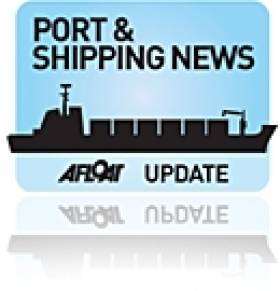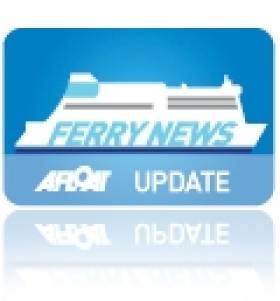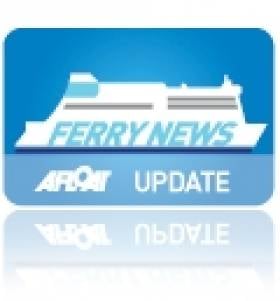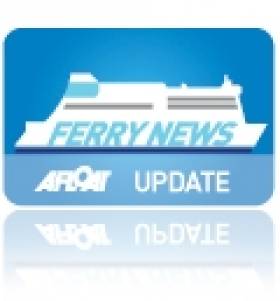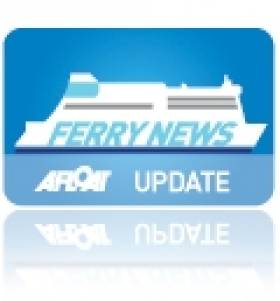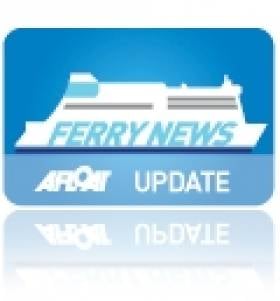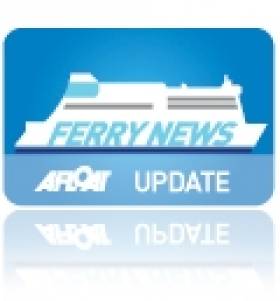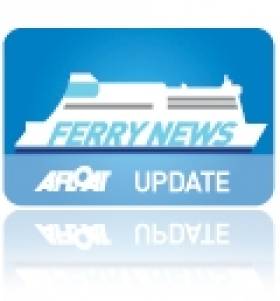Displaying items by tag: Stena Line
Ports & Shipping Review: Cruising to the Sun, WWI Warship’s Tourist Role, Stena’s 50th Year, Cargoship Record, Dock Survey of Lighthouse tender and more…
#PORTS & SHIPPING REVIEW - Over the last fortnight Jehan Ashmore has reported from the shipping scene where Irish passengers left wintery conditions by embarking on a cruise directly from Dublin Port which was bound for sunnier climes in Iberia and the Atlantic isles.
A multi-cat workboat, Island Kestral was acquired by Wicklow based Island Shipping, the vessel will be chartered to offshore projects including the renewables industry sector.
Following the fate of the WW1 Battle of Jutland cruiser HMS Caroline, which is to remain in Belfast, the 98-year vessel is to be made into a tourist visitor attraction, likewise of London's HMS Belfast, another veteran but from WW2.
Those considering a career at sea, should take note that the National Maritime College of Ireland (NMCI) is to host a 'Open' Day next Tuesday (23 October) at the campus based in Ringaskiddy.
What's in a name...Stena Line, a household name, but did you realise that the Swedish owned ferry giant derives its name from founder Sten A. Ollsen, and this year celebrates its 50th anniversary. How did the company become to where it is today, operating 19 routes which includes Dun Laoghaire-Holyhead, served by the HSS Stena Explorer, which is to return to the route for 12 days during the festive and new year periods.
While Irish Sea rivals, Irish Ferries is to add a third ferry on to the Dublin Port-Holyhead route also to cover for the festive and new year sailings. The unprecedented transfer of the Isle of Inishmore will join the route's existing tonnage, Ulysses and fast-ferry Jonathan Swift, to provide additional capacity during the busy season.
Those with a strong interest in liners, should head for the London Ship Show next Saturday (27 October). Among the exhibitors are maritime booksellers, artists, model-makers, traders in memorabilia and ephemera postcards. There will be talks about P&O Cruises 175th anniversary 'Grand Event' in the Solent which featured the Arcadia that sailed to Dublin.
A major international conference on Ocean Energy was held in Dublin's Convention Centre and facing opposite the venue, a scientific weather buoy was positioned on the Liffey.
Passengers travelling on ferry routes will be able to have the same travel rights given to those flying or taking the train, when the National Roads Authority is to implement on 18 December.
A record breaking single cargo shipment of 56,000 tonnes of coal, was set in Belfast Harbour, when the bulk-carrier Ocean Breeze docked in the port having sailed from Virginia in the U.S.
Irish Rail which operates Rosslare Europort is to undergo a strategic review, which is predominantly served by the ferry sector, could be transferred to potentially different ownership.
Today the tallship Tenacious is having an 'Open' Day, where the public can board the 65m barque berthed at Sir John Rogersons Quay in Dublins Docklands between 10.00am-12.30pm and 2-4pm.
The hard-working lighthouse tender ILV Granuaile is undergoing a docking survey in Cork Dockyard. The vessel was built in Galati on the River Danube, Romania for the Commissioners of Irish Lights whose headquarters are in Dun Laoghaire, which is the vessel's homeport.
Irish Sea Central Corridor Ferry Operators Prepare For Seasonal Boost
#FERRY NEWS – Over the busy festive season and during the early New Year periods, Irish Sea 'central corridor' route ferry operators are preparing for an influx of passengers, writes Jehan Ashmore.
Stena Line's HSS Fastcraft will return on the Dun Laoghaire-Holyhead route for the festive season with the following sailing schedule: 20-23 December, 27-30 December and between 2-5 January 2013.
The route is served by the HSS Stena Explorer fastcraft with a crossing time of 1 hour 20 minutes. For further information about the service, click here.
In addition Stena Line operate sailings on the Dublin Port-Holyhead route, which is served by two conventional superferries, Stena Adventurer and Stena Nordica on the 3 hours 15 minute service. For further details click here.
Irish Ferries Dublin Port-Holyhead route is served by cruise ferry Ulysses and fast ferry Jonathan Swift, though for the festive period the cruise ferry, Isle of Inishmore will be introduced to provide an extra sailing in each direction on the following dates: 22, 23 and 27 December and 2 and 3 January 2013.
Passage times on the route for the cruise-ferries take 3 hours 15 minutes and the fast ferry crossing is 1 hour 49 minutes. For more information and sailing times click here.
Also running service on the central corridor is P&O Ferries Dublin Port-Liverpool route which is served by a trio of ro-pax ferries, European Endeavour and sisters Norbank and Norbay.
They operate to a crossing time of between 7 hours 30 minutes and 8 hours 5 minutes, which varies subject to sailing times. On this route, the service does not cater for foot passengers. Details of this service can be found on their website here.
What’s In a Name: Sten A. Ferry- 50 Years in Service
#STENA 50 YEARS- This year marks the 50th anniversary of Stena Line, the household name of the Swedish owned ferry giant. The company took the trading name from founder Sten A. Ollsen who began originally in 1939 with a small chartered cargoship named Dan, after his son, who currently holds several chairman positions throughout the Stena sphere of operations, writes Jehan Ashmore.
The first foray into a passenger (only) ferry was in 1962 with chartered tonnage on a route from Stenpiren in Gothenburg to Skagen in Denmark. The vessel the MS Østersøen was packed with happy, Christmas-shopping Gothenburgers looking for alcohol, tobacco and food at bargain prices! It seemed as if a new phenomenon had started in Gothenburg.
Only two years later the company had announced its first custom-built car ferry, Stena Germanica, which was to serve on the night-service from Gothenburg to Kiel. As the company continued to become successful, more routes were developed and new or chartered tonnage was added.
Among the new vessels ordered during the 1970's was Stena Scandinavia, one of a quartet of well proportioned and handsome looking car-ferries built for Stena's Scandinavian service. She served the Swedish-German route for five years until sold in 1978 to Irish Continental Line (ICL) to become Saint Killian (scroll down) on Irish-French routes.
In 1981/2 she was lengthened and renamed Saint Killian II, a name she retained also with her Irish Ferries career. She was sold in 1998 to Greeks interests, then resold with the vessel chartered to Algérie Ferries. There were also periods of lay-up until she was scrapped in 2007 in Alang, India.
Over the past four decades the Stena Line group has expanded considerably and is one of the world's largest ferry operators with an extensive ferry (and freight) network of 19 routes in Scandinavia and radiating from ports in the UK. In total the routes connect eight countries, served by 35 vessels, and overall the company employ 5,700 people.
Stena Line are running a 50 years with memories! campaign, where prizes are being given away including a year's free travel with the operator, and 5 iPhones, for details click HERE.
Ports & Shipping Review: Stena HSS Comes and Goes, Shackleton Exhibition, Cork Harbour Open Weekend,Cargoship Dispute and Ferry Strike
#PORTS & SHIPPING REVIEW - Over the last fortnight Jehan Ashmore has reported from the Shipping scene where the Stena Line HSS seasonal-only operated Dun Laoghaire-Holyhead service completed its final sailing for the summer, though sailings are to resume over Christmas/New Year period.
Despite the HSS Stena Explorer's last high-season sailing on 11 September, the fast-ferry made a return call to Dun Laoghaire five days later, for a special freight-only charter, to load stage trucks following the Lady Gaga concert held in the Aviva Stadium, Dublin.
Incidentally the ferry terminal in Dun Laoghaire now features a new exhibition space, where the Tanaiste Eamonn Gilmore, T.D. officially launched the Shackleton Endurance Exhibition – 'Triumph Against All Odds'.
The Cork Harbour Open Weekend provided a great opportunity for locals and visitors alike to see what the world's second largest natural harbour has to offer, in terms of activities held on and off the water, including trips to Spike Island.
At Cobh a detained French registered fishing vessel was escorted to the town by the Naval Service OPV L.E. Roisin, following alleged breaches of technical fishing regulations.
A Dutch owned cargoship, the Julia, which docked in Drogheda Port faced arrest, following claims by its crew that they were owed in total $102,700 in unpaid wages to them.
The summer may be over, but that's not stopping Irish Ferries offering Autumn short shopping breaks and wine mini-cruises on the route to Cherbourg.
While rivals Celtic Link Ferries, found themselves taking additional business at short notice, as passengers were transferred from the cancelled Brittany Ferries Roscoff-Cork sailing, following strike-action by French staff over a dispute on new working conditions.
Celtic Link Ferries will however be expecting a response from customers as they take part in Gathering 2013, as the ferry operator are offering free car travel on 15th March next year in advance of St. Patricks Day celebrations.
Leo Varadkar, Minister for Transport, has appointed James Frater to the board of the Dublin Port Company. The Scot has held senior positions at ports in the UK, Egypt, Hong Kong and Oman.
End of High-Season Stena HSS Sailings
#FERRY NEWS- Stena Line's seasonal-only Dun Laoghaire-Holyhead route run by the HSS Stena Explorer finished its last sailing today with a lunchtime departure bound for Anglesey. However the HSS service will return for twelve days over the Christmas / New Year period, writes Jehan Ashmore.
In the interim period the company will maintain their Dublin-Holyhead year-round route served by conventional ferries, Stena Adventurer and Stena Nordica. For information on the 3-hour 15 minute route and sailings schedules click HERE.
This is the second year in which the reduced HSS service has been operating to a single daily round trip, as Stena Line in recent years has strived to reduce costs on the 120 minute route served by the more expensive to run fuel-thirsty catamaran fast-ferry.
When sailings return on the Dun Laoghaire-Holyhead route during the festive period (see details), they are scheduled to run during three short stints, they are as follows: 20-23 December, 27-30 December and 2-5 January 2013.
Stena Line Record Uplift on Belfast-Birkenhead Route
#ROUTE BOOST- Since Stena Line took over the Belfast-Birkenhead (Liverpool) route and two ro-pax ferries last summer, passenger figures have increased, according to PlaceNorthWest.
In June 2012 volumes were up across all measures compared to the same month last year with passenger vehicles recording: 7,577 (2011: 6,773), car passengers: 15,838 (14,342) and foot passenger figure of 2,473 (2,276).
Richard Horswill, Route Director for the route said "A like-for-like monthly comparison between June 2011 and June 2012 shows an increase across the board in vehicles, car and foot passengers travelling on the route.
This is as a direct result of the investment over the last number of months with the £4m refurbishment of the Stena Mersey and Stena Lagan as well as a focus on customer services.
#STENA 50TH ANNIVERSARY – In this 50th anniversary year of Stena Line, the Swedish owned ferry operator has 19 routes stretching from Belfast to Scandinavia. This is set to further expand as Stena have secured approval by German competition authorities to acquire Scandlines, a rival German ferry firm running in the Baltic Sea, writes Jehan Ashmore.
In the deal which is to be finalised in August, Stena Line are take-over five routes and two ships from Scandlines. The routes are mostly freight-orientated services to Germany, Sweden and Latvia would accelerate Stena's position in one of Europe's fastest growing short-sea shipping markets.
Incidentally the Scandlines ferry 'Sassnitz' (1989/21,154grt) featured on last Sunday's BBC One British version of the popular Swedish police drama series 'Wallander'. The vessel operates from Sassnitz in Germany to Trelleborg near Ystad, where the drama is set and in which detective Kurt Wallander is played by Belfast-born Kenneth Branagh who won a BAFTA in 2010 for the leading-role.
It was in Belfast last year that saw several developments by Stena Line taking place, notable the acquisition of DFDS Seaways Irish Sea operations which included the freight-only Belfast-Heysham and Belfast-Birkenhead (Liverpool) routes. Following this was the launch in November of two 'Superfast' ferries onto the new Belfast-Cairnryan route.
This is new territory as Stena have never operated from the Mersey on the 8-hour crossing which also operates night sailings. The route is another first for Stena on the Irish Sea, which is been marketed as one of their 'Overnight Superferry' routes, however they similarly market other routes being: Harwich-Hook van Holland, Frederikshavn-Oslo, Gothenburg-Kiel and Karlskrona-Gdynia.
As part of the deal with DFDS the 27,000 tons ro-pax sisterships Lagan Seaways and Mersey Seaways would remain on the route, as an existing charter arrangement had still to run its course.
To reflect the change of ferry operator, the sisters were renamed Stena Lagan and Stena Mersey and by the end of March this year both of the 980-passenger / 2,662-vehicle deck lane metre capacity vessels, underwent each a £1.5m internal refurbishment at Harland & Wolff and external painting.
The upgrade saw passenger facilities greatly improved compared to a somewhat spartan interiors as prescribed when the ships were completed by Italian shipbuilder Visentini. Since the vessels return to service the pair have been purchased from the charterer by Stena RoRo, the Gothenburg based charter division of Stena Line.
In essence this means that should further refurbishment of Stena style passenger facilities be planned, they can now be carried out without limitations imposed by the previous charter-owners.
Belfast Bids Farewell as Last Harland & Wolff built Irish Sea ‘Sealink’ Ferry Sets Sail
#FERRY DEPARTS FOR INDONESIA – An end of an era was marked this afternoon with the departure of the last passenger ship (including 'Sealink' car-ferry) built by Harland & Wolff, when Portlink, slipped down Belfast Lough, for the last time, for new owners in South East Asia, writes Jehan Ashmore.
Since November the ferry then named Stena Caledonia was withdrwan from Stena Line's Belfast-Stranraer route following the opening of a new €80m ferry terminal at Loch Ryan Port close to Cairnryan. The new route is also operated by a pair of larger, newer 'Superfast' sisterships built in 2001, while the older ferry embarks on a career with PT ASDP Indonesia Ferry (Persero).
Originally Stena Caledonia started her career as the St. David, which was launched in 1981 as the final member of a quartet of 'Saint' class near sisterships for Sealink/ British Rail. With her sale to overseas owners, she was the last of the Saint class still operating in UK waters.
Before today's start of the delivery voyage which includes a port of call to Gibraltar, invariably to call for bunkers, the 31 year-old veteran vessel, had been berthed close to the H&W's Musgrave yard. The St. David became the last vessel launched from that particular yard at the Queens Island complex. Incidentally she would also become the last ever passenger ship built at H&W.
For over the last two decades Stena Caledonia has provided a sterling service operating on the North Channel, firstly from Larne-Stranraer when Sealink was taken over by Stena Line in 1990 and then the route switched several years later to the Belfast-Stranraer route.
While in her earlier career as St. David she operated on two routes she was purpose built for between Dun Laoghaire-Holyhead and Rosslare-Fishguard, though she rarely served on the St. Georges service.
Instead she was deployed mostly on the Dun Laoghaire-Holyhead route alongside St. Columba, where these vessels featured a stern-bridge. The stern-bridge in itself also reflected an end of an era in ferry design, this was to facilitate easier and safer access while navigating the tighter confines of the inner harbour of the Welsh port located on Holy Island.
In between her early and final years on the Irish Sea, St. David also ran on routes from Dover where Sealink /British Rail operated their 'Blue' Ribbon service to Calais maintained by two of her three sisters.
#STENA SALE SHIP- Irish Sea ferry stalwart Stena Caledonia (1981/12,619grt) has been sold to ASDP Ferry of Indonesia according to Ships Monthly. The vessel remains moored in Belfast awaiting her delivery voyage, which will be the longest ever she is to undertake in her career, writes Jehan Ashmore.
All Stena Line funnel and hull markings of the 31-year old vessel have been painted out and she has been renamed Portlink and re-registered in Jakarta, the capital of Indonesia.
Since late November she stood down following the switch of Scottish ferryport from Stranraer to Cairnryan, where a new £80m Loch Ryan Port ferry terminal is served by two newly introduced and luxuriously refurbished sisters Stena Superfast VII and Stena Superfast VIII. The pair built in Germany in 2001 have successfully been introduced on the new Belfast-Cairnryan route.
Initially the Stena Caledonia was laid-up in Belfast at Albert Quay though in recent months she shifted berths to the former Outfit Quay at Harland & Wolff, ironically this location being very close to the facilities Musgrave Yard, where she built as St. David for Sealink / British Rail.
She became the last vessel to be launched from that particular yard on Queens Island and historically she is significant in that she is the last passenger (including car-ferry) vessel to be built by H&W.
Stena Line to Mark History of Wartime Bombed Ferry
#FERRY NEWS - A commemoration plaque in memory to those who lost their lives when the Irish Sea passenger ferry S.S. Patrick (II) was attacked by a bomb from the Luftwaffe during WW2, is to be unveiled in Rosslare Europort next Wednesday.
The tragic attack in 1941 resulted in the 1,922 tonnes vessel sinking with the death of 30 people while the twin-screw steam turbine powered vessel was on passage off the Welsh coast. The ship built in 1930 was launched from the Alexander Stephen & Sons Glasgow (Yard No 525) Glasgow, and she commissioned to serve the St. Georges's channel route between Rosslare and Fishguard.
She had been targeted by a German machine gunner the previous year even though it was not a military vessel and the reasons for its attack have remained a mystery to this day.
Diane Poole OBE, Head of PR and Communications at Stena Line said, "The ship that sank was owned by the Fishguard and Rosslare Railways and Harbours Company (FRRHC), of whom Stena Line along with Irish Rail/Rosslare Europort are descendants.
She added: "Despite the deaths and the trauma attached to the event, the memory of the ship and those who went down with her has largely been lost. There has never been a true commemoration in Ireland of the disaster – until now."
For further information about the tragedy click HERE and a documentary recorded for RTE Radio On can be listened to by clicking this LINK.
The current ferry operating the route is the Stena Europe (1981/24,828grt) which has maintained the route for the last decade. Sailings on the summer schedule will not be boosted by the fast-ferry craft, Stena Lynx III which was sold last year to serve new South Korean owners.



























